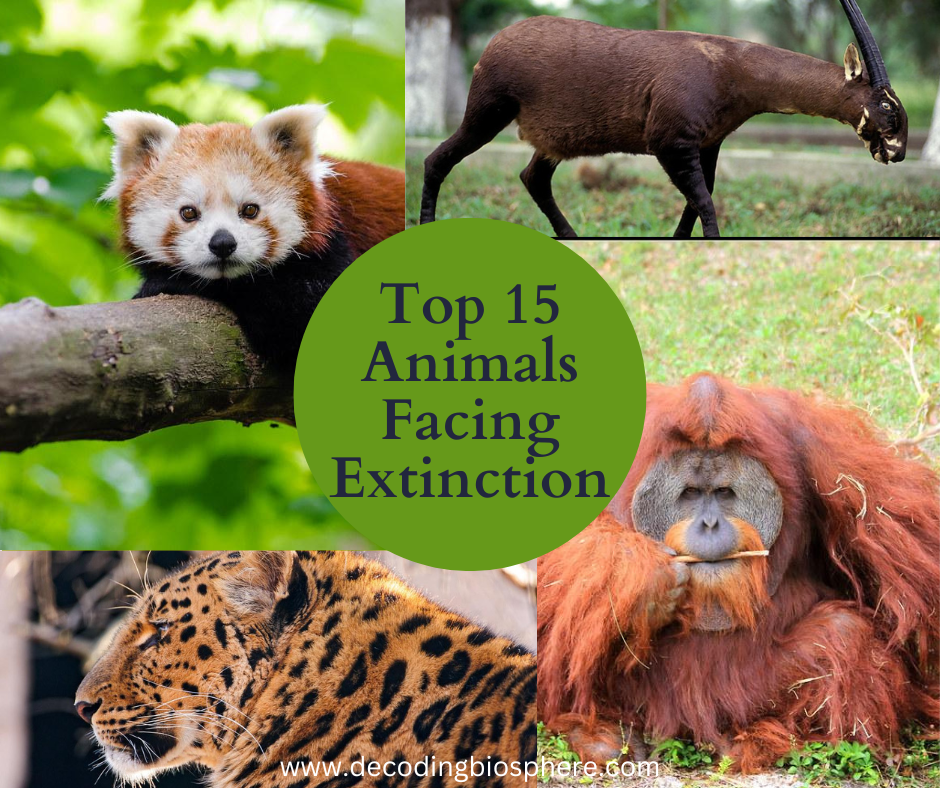In the vast web of life on Earth, each species plays a crucial role. However, due to human activities and environmental changes, many animals are on the brink of extinction. This alarming trend threatens the biodiversity of our planet. In this article, we delve into the plight of 15 animals facing extinction, highlighting the urgency of conservation efforts to save them from disappearing forever.
1. Amur Leopard
The Amur leopard, native to the Russian Far East and northeastern China, is one of the most critically endangered big cats. With only about 80 individuals left in the wild, habitat loss, poaching, and human-wildlife conflict pose significant threats to their survival. Conservation initiatives aim to protect their habitats and combat poaching to ensure the survival of this majestic species.

2. Sumatran Orangutan
The Sumatran orangutan, found exclusively on the Indonesian island of Sumatra, faces grave threats from deforestation and illegal hunting. With less than 14,000 individuals remaining, urgent conservation measures are essential to safeguard their forest homes and ensure their survival.

3. Javan Rhino
The Javan rhinoceros, one of the rarest large mammals on Earth, is teetering on the edge of extinction. With fewer than 80 individuals surviving in Java’s Ujung Kulon National Park, habitat loss and poaching remain critical threats. Conservation efforts focus on protecting their habitats and intensifying anti-poaching measures to prevent their extinction.

4. Vaquita
The vaquita, the world’s smallest and most endangered cetacean, is endemic to the northern Gulf of California. With less than 10 individuals left, illegal fishing practices, particularly gillnets used to catch totoaba fish, pose the greatest threat to their survival. Immediate action is crucial to enforce fishing bans and eliminate illegal trade to save the vaquita from extinction.

5. Saola
The saola, often referred to as the “Asian unicorn,” is a rare and elusive ungulate found in the Annamite Mountains of Vietnam and Laos. With an estimated population of fewer than 100 individuals, habitat loss, hunting, and snaring for the illegal wildlife trade threaten their survival. Conservation efforts aim to protect their forest habitats and reduce poaching to prevent their extinction.

6. Pangolin
Pangolins, often dubbed as the world’s most trafficked mammal, are critically endangered due to illegal poaching and trafficking for their scales and meat. With all eight species facing extinction, conservation efforts focus on combating illegal wildlife trade, raising awareness, and establishing protected areas to safeguard their populations.

7. Black Rhino
The black rhinoceros, native to eastern and southern Africa, is critically endangered due to poaching for their horns, which are highly valued in traditional Asian medicine. With fewer than 5,000 individuals remaining, conservation initiatives prioritize anti-poaching efforts, habitat protection, and community involvement to ensure their survival.

8. Hawksbill Turtle
The hawksbill turtle, known for its striking shell pattern, is critically endangered due to habitat loss, illegal trade in their shells, and accidental capture in fishing gear. Conservation efforts focus on protecting nesting beaches, reducing bycatch, and raising awareness to save these magnificent sea turtles from extinction.

9. Cross River Gorilla
The Cross River gorilla, found in the mountainous forests of Cameroon and Nigeria, is one of the world’s rarest great apes. With fewer than 300 individuals remaining, habitat loss, poaching, and human-wildlife conflict threaten their survival. Conservation initiatives aim to protect their forest habitats, mitigate human-wildlife conflict, and involve local communities in conservation efforts.

10. Bornean Elephant
The Bornean elephant, a subspecies of the Asian elephant, is critically endangered due to habitat loss, fragmentation, and human-wildlife conflict. With fewer than 2,000 individuals remaining in fragmented populations, conservation efforts focus on protecting their forest habitats, establishing wildlife corridors, and promoting coexistence with local communities to ensure their survival.

11. Mountain Gorilla
The mountain gorilla, found in the forests of the Virunga Massif and Bwindi Impenetrable Forest in Central Africa, has made a remarkable recovery from the brink of extinction. However, they remain critically endangered due to habitat loss, poaching, and disease. Conservation efforts have led to an increase in their population, but continued protection of their habitats and strict anti-poaching measures are crucial for their long-term survival.

12. Northern White Rhino
The northern white rhinoceros, once widespread in East and Central Africa, is functionally extinct in the wild, with only two surviving females under human care. Poaching for their horns decimated their populations, highlighting the devastating impact of illegal wildlife trade. Efforts to recover the northern white rhino include assisted reproduction techniques and genetic banking to save this subspecies from complete extinction.

13. Red Panda
The red panda, a charismatic and elusive mammal found in the forests of the Eastern Himalayas, is threatened by habitat loss, poaching, and illegal wildlife trade. With fewer than 10,000 individuals remaining in fragmented populations, conservation efforts focus on protecting their forest habitats, combating poaching, and raising awareness to ensure their survival.

14. Philippine Eagle
The Philippine eagle, one of the world’s largest and most powerful eagles, is critically endangered due to habitat loss, hunting, and illegal logging. With fewer than 400 individuals remaining in the wild, conservation efforts prioritize protecting their forest habitats, establishing protected areas, and engaging local communities in conservation initiatives to save this majestic bird from extinction.

15. Iberian Lynx
The Iberian lynx, native to the Iberian Peninsula in Spain and Portugal, is the world’s most endangered cat species. With fewer than 500 individuals remaining, habitat loss, decline in prey species, and road accidents pose significant threats to their survival. Conservation efforts focus on restoring their habitats, reintroducing prey species, and implementing measures to reduce human-wildlife conflict to prevent their extinction.

In conclusion, the alarming decline of these 15 animals underscores the urgent need for concerted conservation efforts to prevent their extinction. Habitat protection, anti-poaching measures, community involvement, and raising awareness are crucial to safeguarding these species.
You May Also Like

